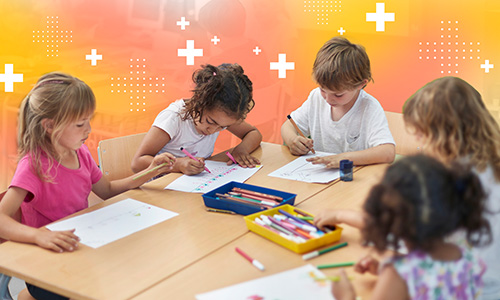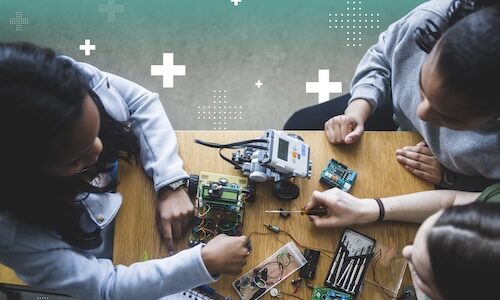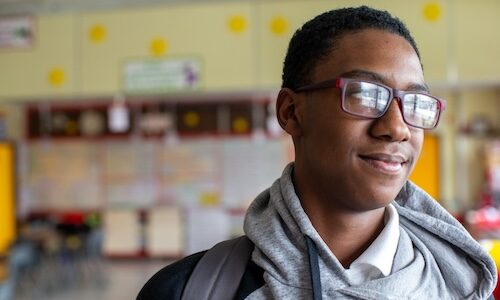
When I was growing up in Michigan, the summers were hot and sticky. You prayed the evening would bring lightning bugs and a cool breeze.
Despite the high temperatures, my Michigan summers were incredible. They were spent mostly with my twin brother and our neighborhood crew, fishing and getting dirty by the creek, riding our bikes, or taking family trips up north to the camp, which hopefully included a visit to a lake and an ice cream shop. But as a student who struggled in school, I always had the looming feeling that summer would soon be over and I would have to face another year of school. Fall was always the hardest.
While most kids have some relearning to do in the fall, mine must have been noticeable because my mom was always nagging me to stay on top of my reading and math in those summer months. She would coordinate with my teachers in June to get materials for me to work on over the break, gently reminding me, “Liz, do your math worksheets. I know you don’t want to do them, but if you don’t, the beginning of the year may be harder. Remember, we need to stay on top of things.”
Summer learning loss is well documented
The research is clear that there are seasonal patterns of learning, in which gains during the school year are followed by flattening or dropping during the summer break. If we know this for all students, what does this mean for students who are already struggling throughout the school year? How are students with disabilities growing within the school year, and how is summer affecting their overall learning?
My colleague Angela Johnson and I were curious and wanted to dive deeper into the following questions:
- How does academic achievement compare between students who were ever in special education services and those never in special education services in each grade between kindergarten and fourth?
- How does growth in achievement compare between students who were ever in special education services and those never in special education services in each grade and summer between kindergarten and fourth?
Understanding how learning is affected over the summer for students with disabilities is not a new concept. When I was a special education teacher more than a decade ago, it was part of my responsibility to understand whether or not my students recouped the learning they lost over summer at a reasonable rate every fall, when compared to their nondisabled peers. Eligibility for extended school year programming was part of the Individuals with Disabilities Education Act (IDEA) and, ultimately, their Free Appropriate Public Education (FAPE). However, this is challenging for teachers because the way that recoupment is measured and the way eligibility for an extended school year is determined depend on the state and district—and there is great variation across the country.
Aware of the varied options kids have, Angela and I turned to the literature to see what other researchers have found on students with disabilities, in terms of growth within the school year and the effects of summer months. To our surprise, we found very little, which indicated a need for our research.
About our research
We conducted our study using data from the NWEA assessment MAP® Growth™ and student-level SPED program information for a cohort of 4,228 students in 109 US public schools across five school years (2014–15 to 2018–19), from kindergarten through fourth grade. It’s important to understand that of this cohort, 786 students were in special education in at least one academic year. We called these students “ever-SPED” and their peers who were never in special education “never-SPED.”
We found that ever-SPED students entered kindergarten with lower test scores than never-SPED students, in both reading and math. While this group entered with lower scores and grew less in the kindergarten year, we did find that during some school years, ever-SPED students grew at higher rates in reading and math compared to never-SPED students. This is not only exciting to see, but also validating of the work that general and special education teachers do throughout the school year. We rarely get the opportunity to celebrate growth for students with disabilities, and it is important that we take the time to recognize the work of both teachers and students.
Lastly, we found larger summer losses for ever-SPED students than for their never-SPED peers, which may contribute to the widening disparities in both reading and mathematics. We feel that these larger summer losses for the ever-SPED group may be accumulating over time, making it difficult for students with disabilities to “catch up” with their non-disabled peers.
Recommendations
Our study made it clear there is more to be done to support SPED students in the summer and fall. We highly recommend the following:
- Educators and researchers should work to identify and provide effective support for struggling students earlier to foster their academic growth in kindergarten. We know that the early years are critical for learning and that students who enter kindergarten behind their peers are not starting their education on an equal footing.
- Educators, policymakers, and researchers should explore how extended school year services may support learning for students with disabilities. As stated earlier, policies vary depending on your state and district. Under some policies, only certain students with disabilities are eligible for extended school year services. This should be explored, and funding should be made available for all students who need learning to continue throughout the summer months.
- Families can support kids with engaging learning come summer. Continued learning for SPED students is key, but it does not have to be a chore. It can be done at the student’s pace and supported through exploration and fun activities. If you’re a family member, consider your local library’s reading challenge and do a mix of audio books and leveled readers. Remember, too, that your child does not have to be challenged constantly. Repetition can do wonders! Also talk to your local community centers to see what they have to offer. Some group activities for students are so fun that your child won’t even realize they’re learning. Finally, discover your neighborhood. Spend time investigating the world around you, together, to help build vocabulary. Grab a book on plants or clouds from the library and head out before or after work. A 10-minute walk is sometimes the most educational.
Recognize the effort SPED kids make year-round
When I was a child, nothing felt more comforting to me than a hug from my mom. And when she recognized that I was bummed out about having to do schoolwork during the summer, she would pull me in, hug me tight, and say, “Someday, this too, will pay off.”
Validating our students is powerful. Celebrating the learning they are achieving during the school year is vital. Students with disabilities are working doubly hard to achieve and keep up with their non-disabled peers. They need rest, they need play, and they need compassion. My summers were glorious, and running into the house, washing the dirt off my hands, and grabbing a book to read for 20–30 minutes definitely paid off.







